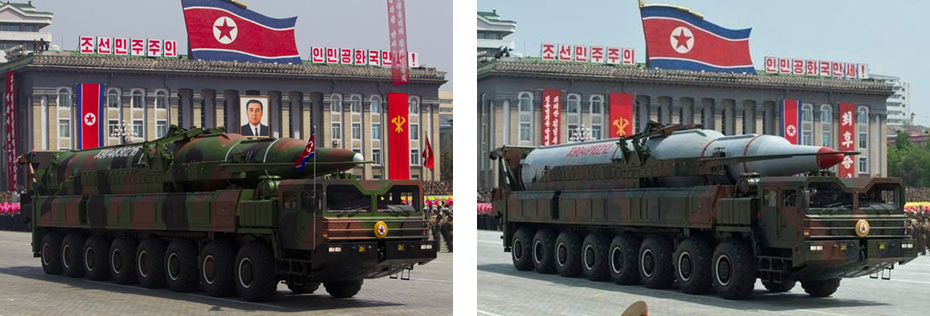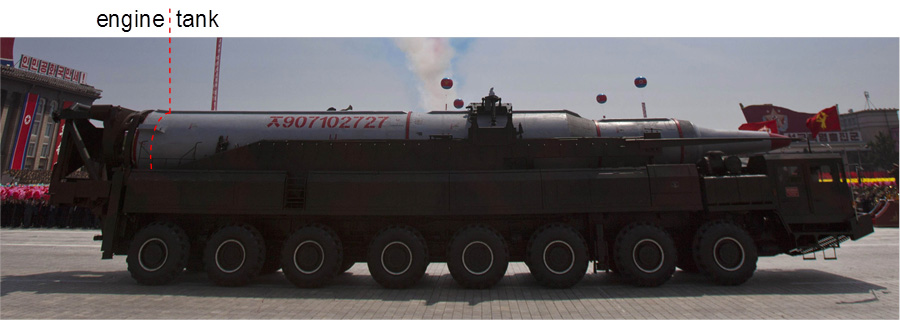Assessment of North Korea’s Latest ICBM Mock-Up1
Amid much controversy over the successful Unha-3 launch in December 2012 and the third nuclear test in February 2013, North Korea decides to roll out a mock-up of its new flagship missiles during the July 2013 parade commemorating the 65th anniversary of the armistice. Setting aside the question of North Korea’s ability to miniaturize and arm a nuclear tipped warhead, we provide an assessment of North Korea’s long range delivery capability based on the high definition images taken from the parade. We then consider why North Korea continues to exhibit a flawed mock-up of the intercontinental ballistic missiles and suggest some policy implications that can be derived from our finding.
Figure 1: North Korean ICBM at Parades in April 2012 (left) and in July 2013 (right)
What We (Don’t) Know
More than 1.5 years after its public roll-out in the April 2012 parade, the debate about the North Korean road-mobile ICBM continues. There is still no proof either way whether this missile, referred to as the KN-08 or Hwasong 13, is real or not.
Instead of ending the debate once and for all by publishing video footage of a static test, or even flight testing the KN-08, North Korea remains very tight-lipped about its new flagship missile. This policy of opacity however is in line with North Korea’s latest addition to its missile arsenal, the so-called Musudan: even though declared as operational and allegedly deployed for years, there is still no direct proof of its existence for the public, only mock-ups at parades hint at this mystery missile. So far, the same is true for the KN-08.
Of course, we do not mean to downplay the threat that the North Korean military poses on its immediate neighbors. While North Korea fields an aging force with Cold War legacy hardwares, they maintain a large forward deployed presence with an evolving nuclear program and a sizable ballistic missile capability.2 However, as our assessment will show, there is reason to question the extent to which their latest display of the KN-08 mock-up suggests any hints of significant development in their missile program.
We begin our discussion by considering few events over the last 1.5 years that may be related to the North Korean ICBM program, including the successful Unha-3 satellite launch, the third nuclear test in North Korea, and reports of five static engine tests in 2013.
Unha-3 (December 2012)
It is generally assumed that the KN-08 is based on Soviet liquid rocket technology, either the well-known Scud technology or the more advanced R-27/SS-N-6 technology.3 The Unha satellite launcher definitely relies on Scud technology in its first stage, and most likely also in its second stage. The open source knowledge about the third stage is too limited to allow for a credible statement. The Musudan missile looks like a modified R-27, but as mentioned above, there is no direct proof that the Musudan is real, and no flight tests have yet been observed.
With that, North Korea so far has only demonstrated that it mastered the Scud technology. In light of the lengthy Unha development program (more than 20 years until first successful flight in 2012), it seems doubtful if mastering the more advanced R-27 technology would take less time. Since the R-27 technology also offers more performance than Scud technology, it also seems strange that North Korea would spend serious efforts on the Scud technology for their satellite launcher, and in parallel smoothly apply R-27 tech on its ICBM project, without any spill-over effects to the Unha.
Nuclear Test (February 2013)
The 2013 nuclear test is sometimes linked to advances in warhead miniaturization, which would make sense for an ICBM, but it seems that there is no evidence underlining this hypothesis except for the postulated existence of the KN-08 itself. This makes a good example for circular reasoning: the North Koreans apparently miniaturize nuclear warheads because of the ICBM program, and the ICBM program exists because they are miniaturizing nuclear warheads.
Static Engine Tests (2013)
The reports of five static engine tests at the western launch site over the year 2013 might be seen as an indication for an advancing KN-08 program, but these tests could just as well involve firings of the Unha’s first or second stage, or simple Nodong or Scud engine tests. For a serious engine development program, five firings over the course of almost one year is definitely way too low. (Just as a comparison: The qualification program alone for Space X’s Merlin 1D engine – the fourth revision of its Merlin 1 engine – included 28 test firings until March 2013.)
This only leaves the July 2013 parade as a possible hint to the KN-08 program.
ICBMs at the Parade (July 2013)
In a recent article,4 Jeffrey Lewis and John Schilling argue that the increase of quality in the KN-08 mock-ups – observed in the July 2013 parade – indicates steady progress in an advancing development program.
Observers tend to forget that one of the reasons for a military parade is to show something to the public (domestic and external). This means that a parade always is a show of force, intended to transmit a message. It is also a perfect setting for spreading disinformation.
In this context, it should be mentioned that, since the early days of the Cold War, only mock-ups of missiles have been presented at parades, no matter if the displayed missile type is operational and deployed, or if it only exists on the drawing board.5 Missiles are space technology, they are extremely expensive pieces of hardware, and they are assets that every country has limited access to. No one risks damaging these precious assets by driving them hundreds of kilometers through the country just to show them to an audience that usually has no clue about missiles, except perhaps for a handful of rocket scientists like us. There are other reasons, too. Armed forces are always obsessed with secrecy, and not showing the real missile gives you the option of keeping some secret. This allows the military to conceal the true status of a program, regardless of its stage of advancement.
Considering this, one might argue that the presented mock-ups of the KN-08 are in line with a course of deception that is intended not to reveal too many details of the real missile due to secrecy, therefore using mock-ups that differ from each other, and also deliberately incorporating small “mistakes” into these mock-ups to confuse analysts.
However, several details visible on every KN-08 mock-up indicate that the designers had only limited experience on how a real missile works and how it is operated, and therefore how it should look like.
One minor example is the size of the first stage engine compartment. The rows of rivets only reach into the missile body for about half a meter or less, showing the maximum length of the engine compartment (see Figure 2). Engines capable of powering such a rocket would require at least three times that length. For the displayed designs, this requires the engines to be submerged in the tank. While this configuration is used for Soviet liquid-fueled submarine missiles since the 1960s (starting with the R-27/SS-N-6 which is said to be available in North Korea), there simply is no point in using this tech for the displayed KN-08 because length is not an issue for a land-based launch. Submerged engines were used to reduce a missile’s length, an issue important enough for submarine missiles to trade against the much higher complexity, and with it, the increased risk of failure. The KN-08, however, is almost 2 meters short of the vehicle length. Only Western spaceflight engineers sometimes choose a more complex and costly path when there are other options available; the Unha design clearly tells us that the North Korean engineers are not.
Figure 2: First Stage Engine Compartment of the KN-08/Hwasong 13
Aware of this, Lewis and Schilling assume that the most likely KN-08 configuration uses a cluster of two Nodong engines for the first stage – a reasonable option. In that case, however, the mock-ups are plainly wrong. The Nodong engine is not designed as a submerged engine, and no one quickly develops a new submerged engine with only a handful of static tests, especially if he still relies on Nodong engines in his space launcher. Therefore, the KN-08 should feature a large engine compartment.
This is only one of many more examples where the mock-ups don’t make much sense, and some of the others are even more convincing. While these details should not be discussed here – for every North Korean to read and do better next time – they are too numerous to credit the design team with clever deception. They look much more like accidental mistakes.
The poor design approach is even more confusing in light of the common hypothesis of North Korea as a nation as missile geniuses – a country that allegedly reverse engineered the Scud B, advanced it to the Scud C and on to the Scud D, derived the Nodong from the Scud B, designed, built and launched the Taepodong I and the Unha space launchers, built the indigenous KN-02 copy of the Russian SS-21/Tochka, and adapted R-27/SS-N-6 technology for the Musudan missile. It seems implausible that they would not know how to make an ICBM mock-up look like a real rocket, even when the design is in its early stage.
A seasoned missile engineer should have no problem to producing a basic missile design within a few weeks (designing a missile is the easiest part of a missile program – turning the design into reality is what a missile program is all about!). Details will change during the development process, but the first baseline design should be consistent in itself. The presented KN-08 mock-ups are not, neither those from April 2012, nor those from July 2013.
There are several explanations that come into mind.
– The mock-up team may be different than the real design team. In that case, the mock-up design is detached from the real rocket design, and thus worthless for assessment, especially if experts try to derive technical details from the mock-up design.
– Lewis and Schilling argue that the designers are “learning by doing”, that the mock-ups are closely linked to the design process. If true, however, this means that the missile design team has no clue about what it is doing. This can only be the case if the team has had no prior experience with real missile design. In this case, one has to wonder why North Korea would set an inexperienced team in charge of its most important strategic asset – it is no secret that the probability of success for an inexperienced team developing a real ICBM from scratch is zero
It is also unlikely that the design team would produce six several widely identical mock-ups before April 2012, and then again several more mock-ups with higher details before July 2013. It is more likely that the displayed mock-ups were produced exactly for that purpose to show them at a parade.
On a somewhat related note, it also seems strange that a nation that quickly develops a road-mobile ICBM is not capable of quickly producing an adequate ski lift for its leader’s pet project, the prestigious Masik Ski Resort.
In light of all these considerations, the increased quality of the July 2013 mock-ups looks more like a simple response to the worldwide amusement about the poor April 2012 display.
The Logic Behind Smokes and Mirrors
To be clear, we established one fact in the above discussion – we simply do not know whether North Korea, in fact, possesses the missile capability that it claims. Even when North Korea seems willing to showcase its capability with these mock-up parades, we only have clues that give us a probabilistic sense as to whether North Korea in fact possesses these capabilities. What we know from our assessment of the mock-ups at the recent parade is that there is more evidence in support of the likelihood that North Korea does not possess these capabilities. But we are only talking about this issue in probabilistic terms – not with any certainty. So what else can we say if anything at all about these parades and poor mock-ups?
Where data is lacking, theory reigns. Game theoretic understanding of strategic interaction and signaling provides an explanation as to why a weaker player (in this case, North Korea) would choose deception and opacity to deter possible attacks by a stronger opponent (such as South Korea, US and/or Japan).7. By revealing mixed signals about the readiness of its missile program, North Korea can make a stronger opponent indifferent between choosing to attack or not (thereby reducing the likelihood that the opponent would attack); similarly, a stronger opponent’s probability of attacking could be just enough that North Korea would be indifferent between developing a strong defense capability or not. In short, there is a strong rationale for why North Korea (if it did not possess these capabilities) would choose to keep its foes guessing – which is exactly what they are doing.
Of course, if the likelihood that North Korea possesses a working ICBM is sufficiently high (e.g. a successful flight testing, for instance), then the weapons they are parading around would, in fact, be the mock-up of the real thing or the real thing itself. But as our discussion above suggests, we haven’t seen enough evidence to suggest that this is the case. So then why go through the trouble of showing the world these mock-ups? Strategic logic suggests that this is the next best strategy short of actually possessing the capability itself. Let’s be clear, we never claimed with certainty that North Korea does (not) possess these capabilities – instead, what we argue is that it is highly questionable that they do given the evidence that we have. One thing we know for certain about North Korea’s ICBM is that we simply do not know enough, which also seems to be the case for other matters having to do with this mysterious country. And we have also described the strategic rationale for choosing to display these mock ups even if these capabilities did not exist.
So What?
Based on what little evidence we can gather, we’ve reasoned out why we think North Korea does not possess a working ICBM capable of delivering a payload to areas beyond the 3400 mile radius. What this also suggests is that there is time – on both sides of the fence: North Korea has the time to develop its long range missile capability or deter its enemies from considering a preemptive strike; and the allies (i.e. the US, South Korea, and Japan) have the time to find a way to deter North Korea from developing the long range missile capability or consider a preemptive attack. Of these two options, preemption should likely be ruled out given that North Korea already poses a serious threat to its immediate neighbors and a preemptive attack on North Korea would mean a full-scale regional conflict which will result in significant losses for South Korea and Japan9.
This leaves us with deterrence. In addition to the Combined Forces Command (CFC) and military presence in South Korea, the US and ROK signed a pact on deterrence in October 2013 which reportedly includes a call for preemptive strikes against North Korea if there is an indication that DPRK is preparing a nuclear attack. However, making the correct a priori judgment as to whether North Korea is actually staging a nuclear attack will be difficult if not impossible. There are other options, such as maintaining a readiness posture that does not “increase or undercut deterrence in the eyes of the North Koreans.” As suggested by Michael McDevitt, concrete steps that the allies can undertake in this regard include: 1) delaying OPCON transfer, 2) exempting CFC from the notion of strategic flexibility (thereby committing the USFK to the peninsula), 3) developing a tactical solution for conventional strike against Seoul, and/or 4) firm declaratory statements to signal the alliance’s resolve against nuclear North Korea.
Given that the threat is likely to be in the form of an ICBM, however, the US and its allies might also consider further emboldening their missile defense (MD). If North Korea eventually succeeds in developing a working ICBM somewhere down the line, the tables would have turned for the allies. Instead of posturing for readiness against a nuclear North Korea that threatens its neighbors and thereby solely necessitating a theater-based conflict, the US may want to consider deployment of MD interceptors closer to the threat given that North Korea’s intention of developing a working ICBM has been made through the display of these mock ups. This move, however, requires South Korea to become an active participant in the regional antimissile framework led by the US. At the moment, South Korea maintains its own missile defense system (i.e. Korea Air and Missile Defense – KAMD) against threats in the terminal range. By participating in the US-led Ballistic Missile Defense System (BMDS), the allies would be able to place various midcourse defense and sensor segments to handle threats more effectively. Early warning capability that includes networked sensors (e.g. sea-based X-Band Radar and early warning radar) along with a chain of mid and long range interceptors would provide an integrated and layered defense to better handle ballistic missiles of all ranges.
Conclusions
By unveiling the ICBM at the public parade, North Korea tried to impress the world with the mock-up of a high-end product that would be challenging even for seasoned Russian and U.S. missile designers, featuring extreme lightweight design (required for an ICBM that small), submerged engines, and even something that is probably intended to look like a complex post-boost-system against missile defense. However, evidence suggests that they missed some important details.
It is important to point out that a KN-08 missile could be under development nonetheless. If the North Korean regime decides to develop a road-mobile ICBM, it is reasonable to assume that their engineers would not dare deny this wish, and start a “program”, no matter how futile their efforts might be. Therefore, the possibility should not be dismissed that the point of this “program” is not only to fool the US and its allies, but also – to a certain degree – the North Korean leadership. What this means, of course, is that there is still time till North Korea actually possesses this capability.
As Lewis and Schilling state, the simplest explanation is usually the right one. However, it is difficult to see how building a road-mobile ICBM to threaten the continental US without a reliable test program (and only with a proven track record of a two-decades-spanning development effort for a rudimentary satellite launcher made of existing components) is the simplest explanation. Trying to impress the world with simple means to stabilize their regime and avoid external intervention seems like an equally simple if not a simpler explanation. So far, success proves them right.
The views expressed herein do not necessarily reflect the views of the Asan Institute for Policy Studies.
-
1
The authors would like to thank Choi Kang and Hahm Chaibong for thoughtful comments and feedback on previous versions of this paper.
-
2
Office of the Secretary of Defense, Military and Security Developments Involving the Democratic People’s Republic of Korea, Annual Report to Congress, February 15, 2013.
-
3
John Schilling, “A Revised Assessment of the North Korean KN-08 ICBM,” Science & Global Security 21, no. 3 (2013): 210-236. http://scienceandglobalsecurity.org/archive/2013/09/a_revised_assessment_of_the_no.html.
-
4
Jeffrey Lewis and John Schilling, “Real Fake Missiles: North Korea’s ICBM Mockups Are Getting Scary Good”, 38 North, 04 November 2013. http://38north.org/2013/11/lewis-schilling110513/.
-
5
Real programs always have various mock-ups of various quality for various tasks. For the R-17/Scud B, there were special training models with electric circuits (8K14U), weight models that were also used to exercise fueling procedures (8K14GWM), and inert training models based on real rockets (8K14UT). It is known that the East German rocket forces presented these detailed mock-ups on parades, together with special “parade rockets” that were manufactured just for this reason. They were missing the engines, but the airframes looked like the real thing.
-
6
In contrast, the Soviet SS-20 launch container protruded about 2 m beyond the vehicle’s front.
-
7
Drew Fudenberg & Jean Tirole. 1991. Game Theory. MIT Press. pp.324-335. Cotton, Christopher and Chang Liu. 2011. “100 Horsemen and the empty city: A game theoretic examination of deception in Chi-nese military legend.” Journal of Peace Research. 48:217-23.
-
8
Ralph A.Cossa. “North Korean Regime” PacNet #90. December 17, 2013.
-
9
Bruce E. Bechtol Jr., “Planning for the Unthinkable: Countering a North Korean Nuclear Attack and Management of Post-Attack Scenarios”, NAPSNet Special Reports, October 06, 2011, http://nautilus.org/napsnet/napsnet-special-reports/planning-for-the-unthinkable-countering-a-north-korean-nuclear-attack-and-management-of-post-attack-scenarios/
-
10
Michael McDevitt. “Deterring North Korean Provocations” Brookings East Asia Commentary. February 2011.

 Facebook
Facebook Twitter
Twitter



